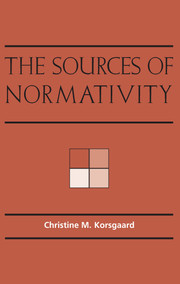Book contents
- Frontmatter
- Contents
- Notes on the contributors
- Acknowledgments
- Introduction
- Prologue: Excellence and obligation a very concise history of western metaphysics 387 bc to 1887 ad
- 1 The normative question
- 2 Reflective endorsement
- 3 The authority of reflection
- 4 The origin of value and the scope of obligation
- 5 Reason, humanity, and the moral law
- 6 Morality and identity
- 7 Universality and the reflective self
- 8 History, morality, and the test of reflection
- 9 Reply
- Bibliography
- Index
1 - The normative question
Published online by Cambridge University Press: 20 May 2010
- Frontmatter
- Contents
- Notes on the contributors
- Acknowledgments
- Introduction
- Prologue: Excellence and obligation a very concise history of western metaphysics 387 bc to 1887 ad
- 1 The normative question
- 2 Reflective endorsement
- 3 The authority of reflection
- 4 The origin of value and the scope of obligation
- 5 Reason, humanity, and the moral law
- 6 Morality and identity
- 7 Universality and the reflective self
- 8 History, morality, and the test of reflection
- 9 Reply
- Bibliography
- Index
Summary
Do not merely show us by argument that justice is superior to injustice, but make clear to us what each in and of itself does to its possessor, whereby the one is evil and the other good.
PlatoINTRODUCTION
In 1625, in his book On the Law of War and Peace, Hugo Grotius asserted that human beings would have obligations ‘even if we should concede that which cannot be conceded without the utmost wickedness, that there is no God, or that the affairs of men are of no concern to Him’. But two of his followers, Thomas Hobbes and Samuel Pufendorf, thought that Grotius was wrong. However socially useful moral conduct might be, they argued, it is not really obligatory unless some sovereign authority, backed by the power of sanctions, lays it down as the law. Others in turn disagreed with them, and so the argument began.
Ever since then, modern moral philosophers have been engaged in a debate about the ‘foundations’ of morality. We need to be shown, it is often urged, that morality is ‘real’ or ‘objective’. The early rationalists, Samuel Clarke and Richard Price, thought that they knew exactly what they meant by this. Hobbes had said that there is no right or wrong in the state of nature, and to them, this meant that Tightness is mere invention or convention, not something real.
- Type
- Chapter
- Information
- The Sources of Normativity , pp. 7 - 48Publisher: Cambridge University PressPrint publication year: 1996
- 17
- Cited by

